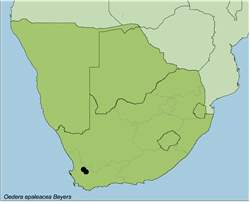Names and synonyms
Oedera epaleacea Beyers
Type
Beyers 272, Western Cape, 3219DC: Swartruggens, on Farm Zeekoegat, southwest of the farm road about 500 m from the turnoff on the road to Katbakkies Pass, 1 030 m, 2000-09-05 (NBG, K, PRE, UPS).
Derivation of names
Oedera = after George Christian Oeder (1728-1791), professor of Botany in Copenhagen, author of Flora Danica
e- = without; paleaceus = chaff, with chaffy bracts, scale-like
Description
Erect, moderately to densely branched, rounded shrub, up to 0.6 m tall, with a stout trunk up to 50 mm diam. Branches ascending-erect, glabrous, leafy, becoming nude and marked with leaf scars. Leaves alternate, spreading, sessile, entire, midribbed, narrowly oblong, 4-12 x 0.8-1.5 mm, glabrous, densely and distinctly glandular -punctate and foveolate, mucronulate; semi-terete in cross section. Capitula solitary, sessile, terminal, heterogamous, radiate. Involucre bell-shaped, 4-5 mm wide. Involucral bracts 5- or 6-seriate, 36-17, imbricate, firm and hard basally, scarious apically, midribbed, glabrous; outer ovate, inner gradually longer, narrowly elliptic and apically brown, innermost narrowly obovate or narrowly oblong with a spreading, brown apical limb, up to 10.3 x 1.7 mm, acute. Receptacle slightly convex, with short scales. Ray florets female, fertile, 13-18; lamina 6-10 x 1.3-2.2 mm, yellow with a dorsal, brown stripe, 4-veined, apically minutely 3-lobed. Disc florets 38-42, female sterile; corolla 3.7-5.5 mm long. Cypselas almost terete or angular, narrowly elliptic, 1.8-2.6 x 0.5-0.7 mm, densely pilose; those in disc florets somewhat smaller, glabrous or sparsely pilose, may be scattered with � stalked glands. Pappus crown-like, of � connate scales, up to 0.6 mm long.
Flowering time
June to September.
Distribution
Only known from a few localities in the Swartruggens area.
Known from fewer than 10 specimens.
Habitat
In arid fynbos, in crevices between rock sheets, in sandstone-derived sandy soils, in full or partial sun.
Notes
O. epaleacea is related to O. foveolata and O. sedifolia, which are recognized by their glandular -punctate leaves.
References
BEYERS, J.B.P. 2001. A new species of Oedera from Western Cape, South Africa. Bothalia 31: 41-42.
KESTING, D. & CLARKE, H. 2008. Botanical names, what they mean. Wild Flowers of the Cape Peninsula, 3rd revised edition. Friends of Silvermine.
